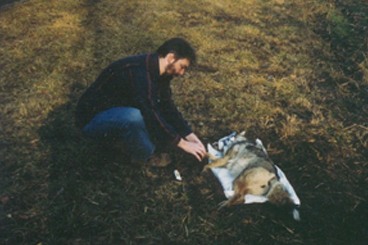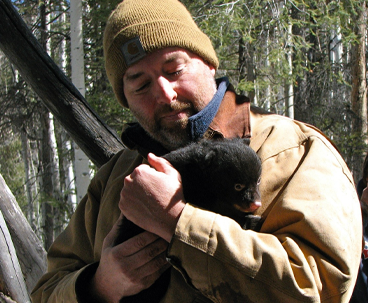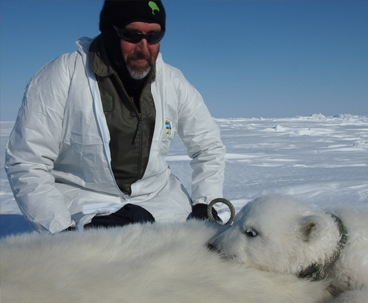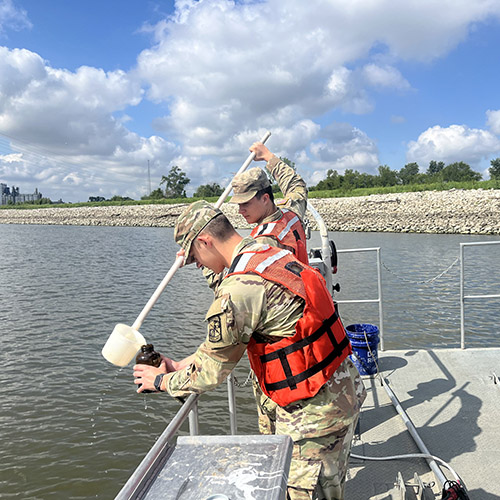Atwood Honored as FNR Distinguished Alumnus
“It is never too late to be what you might have been.” – George Eliot
During his late twenties, Todd Atwood made a bold decision, to give up his career as a professional musician and go back to school. Trading the rush of playing guitar for ecology classes eventually led to the excitement of exploring the Arctic marine ecosystem researching polar bears.
“I was one of those musicians that was working other jobs to make ends meet and doing the musician stuff in the evenings,” Atwood explains. “I did that for a while and realized that I was just spinning my wheels and needed to get an education and a traditional career. I definitely had an interest in animals when I was growing up, but I didn’t have any exposure to wildlife professionals, so I didn’t know that there was a profession out there where I could channel that interest and those energies.
“Now, I tell people that my job is 90 percent sitting behind a computer and 10 percent alternating between sheer terror and boredom flying around in a helicopter. We do all of our work out of a helicopter. When we are doing field work we’re looking to either biopsy dart capture bears, which includes marking them, collecting biological samples and putting radio collars on them. The first time I saw a polar bear on the sea ice was pretty amazing. It’s an environment that is so stark and unforgiving, but there’s so much biological productivity that you are not aware of that it’s a really interesting and unique ecological setting to work in.”
So how did Atwood get from playing gigs to working with polar bears in Alaska? It all started when he took some general survey courses in a variety of subject areas and latched on to the biology course work. He then took some ecology classes at Purdue Calumet in Northwest Indiana, including one in the field at the Indiana Dunes National lakeshore. That course exposed him to tasks performed by wildlife biologists, such as vegetation surveys, and offered an introduction to some of the career opportunities available in wildlife.
Learning about The Wildlife Society while at Calumet and reading TWS associated journals broadened Atwood’s horizons even further. Eventually, Atwood transferred into the wildlife program at Purdue, kicking off a career that has led him to be one of the premier polar bear researchers in the world.
“Coming to Purdue set the trajectory for everything that’s followed,” Atwood points out. “I met some really interesting professors that harnessed my interests and helped me hone the direction I wanted to take my career. I noticed in the bios at the end of every research paper in the Wildlife Society Bulletin, that in order to do research you needed at least one graduate degree, probably two. So, by the time I arrived to the wildlife program in West Lafayette, I knew that I was hopefully going to go on for a PhD, so I used the opportunity as a bachelor’s student to really set the stage for getting my master’s degree.”
Atwood identified professors who were doing work in his area of interest and worked with them on independent studies, or mini-research projects, that gave him the experience and some skills he would need in the future.
“I primarily learned through the experiences of things going wrong when you are doing research, from having to problem solve your way through those issues, which is something I’m still dealing with today,” Atwood stated matter-of-factly. “Nearly every day something goes wrong and you have to problem-solve your way through. That gave me a base of experience that I could apply to my master’s project. When I got to my master’s it was pretty smooth sailing for me because of the fair amount of experience I had as an undergraduate.”
Dr. Mickey Weeks did some white-tailed deer mineral lick work at the CRANE Naval Surface Warfare Center in southern Indiana, which synced with Atwood’s desire to work with large mammals. Atwood’s involvement in the project included two summers of camera trapping at the mineral licks and led him to work with Dr. Weeks on his master’s project.
There were many other impactful experiences at Purdue that have stuck with Atwood throughout his career.
“I was never really confident in my quantitative skills,” Atwood said. “Those have always been daunting for me, so taking classes from Dr. Rob Swihart, the quantitative ecologist on the faculty, and doing well in those classes helped build my confidence. I really credit him with being so charitable with his time, being available when you had questions, and working through problems with you – not telling you what the answer was, but helping you work through to find the answer. Doing well in his population dynamics class, which probably still makes people sweat, was huge for me.
“There are several other classes you don’t realize at the time that you are going to rely on later. When I took dendrology, I thought I was going to learn the plants and trees that were native to central Indiana and that would be the end of it. But as a biologist doing any type of habitat work, the skills that you gain from a class like that when you are doing field labs are always with you and really valuable. There were also some natural resource policy classes that were required at the time, and now that I work with a threatened species and my research gets used by management agencies and translated into policy, I have a greater appreciation for them. And lastly, any class that had group work was important. The skills you develop in working with people who have different ideologies and work ethics than you are really critical and underappreciated. Everything you do as a wildlife biologist is group-oriented.”
Atwood completed his master’s degree at Purdue after studying coyotes and their ecology along an urban-to-rural gradient. That set the table for a Ph.D. opportunity at Utah State University, working under Eric Gese, studying wolf recolonization and how it impacted coyote, elk, and mule deer behavior in the Greater Yellowstone Ecosystem.
After receiving his Ph.D. in 2006, Atwood began his career in wildlife biologist positions across the country, beginning with a research biologist position working with black bears and mule deer for the Arizona Game and Fish Department.
“I did that for a couple of years, but when I decided I wanted to have a career in research,” Atwood said. “I knew that I wanted to be a federal researcher because the breadth and scope of federal research has a broadly applied conservation aspect to it. When the opportunity to work for a federal agency opened up, I jumped on it and that became four or five years of doing carnivore disease ecology for the National Wildlife Research Center.”
That position as a research wildlife biologist for the USDA/APHIS/National Wildlife Research Center in Colorado saw Atwood study species ranging from gray foxes and coyotes to bobcats and black bears.
In 2012, Atwood was hired as a research wildlife biologist and the Polar Bear Research Program Leader for the U.S. Geological Survey’s (USGS)Alaska Science Center in Anchorage. In this role, he collects and analyzes data on polar bear population dynamics and their responses to changing environmental stressors, primarily the loss of sea ice habitat. He then provides scientific guidance on polar bear ecology to various stakeholder groups and decision-makers.
Polar bears, which were listed as a threatened species under the U.S. Endangered Species Act in 2008, are a Trust Species for the Department of the Interior because of international and bilateral country to county conservation obligations. The ultimate goal of the USGS Polar Bear Research Program is to provide information to ensure the long-term persistence of the species and to inform management and policy decisions on a global and national scale. The research is centered on understanding the effects of the changing Arctic on polar bear population health and the implementation of a recovery plan for polar bears. Current research includes investigations into the food web and population dynamics, foraging ecology, population genetics and health.
Through the Methods Development Project, the Polar Bear Research Program is aiming to develop new tools and less invasive methods for collecting data. The project utilizes an interdisciplinary team, including physiologists, remote sensing scientists, materials engineers and unmanned aerial systems (UAS) operators, to develop and test new tools for monitoring polar bears.
The Polar Bear Research Program studies the Chukchi Sea population shared with Russia and the Southern Beaufort Sea population shared with Canada.
“It’s challenging, but it is rewarding,” Atwood says of his work. “Our sole job is to collect information, analyze it and make it available to decision-makers, so they can use it to inform their policy decisions or choose to ignore it. We are pretty clear about not engaging in policy issues with the Survey. Within the international conservation community there is a group called the Polar Bear Specialist Groups and we meet regularly to discuss the state of polar bears in each of the five polar nations. There’s a lot of collaboration between those biologists, because the policies and decisions that get made regarding polar bear management affect a lot of people as well as the species itself.”
In his career, Atwood has published more than 70 peer-reviewed publications and obtained more than $5 million in competitive funding. His work has been featured in three documentary pieces, including “The Great Polar Bear Feast” (BBC/PBS 2015) and “Frontier Scientists” (Alaska Public Media PBS 2016), and numerous other radio, print and television programs.
“Todd works on polar bears, one of the most charismatic megafauna in the world, and that is a really tough topic,” said Dr. Robin Russell, fellow 2021 Distinguished Alumnus Award recipient in her nomination of Atwood. “The fact that he has made some headway with that and been able to negotiate all of the politics and the social aspects of that and is still willing to keep coming back for more is great. He’s publishing and getting a lot of science products out there, but he’s also making an impact on polar bears, despite all of the slings and arrows.”
Atwood said the most rewarding parts of his job are the projects that make a direct impact as well as the personal goals he has reached, rather than any recognition he has received or publications he has put out.
“When you get to the point in your career where I am at, you get a lot of rewards from how your research is used or to the extent that your research is used by people,” Atwood said. “I might publish a paper in a really highly respected journal and that’s great, but I might publish a report that the Fish and Wildlife Service then takes to alter a mitigation measure for polar bears to protect dens in the winter. That is really impactful work. The report informs a decision that the polar bears benefit from and that is really important to me.”
“I have accomplished some of my personal goals. I have become a federal researcher. I got a bachelor’s degree and two graduate degrees, pretty good for a guy from Northwest Indiana who didn’t come from a family where academia was a primary interest. Getting to lead the polar bear program is something special for me. When I was finishing my PhD and having the perfect job discussion with an officemate, I said, I want to study polar bears. And now I am. Personally, I have checked off my goals. The last thing I want to do professionally is to really set the polar bear program up for success over the next 20 to 30 years, which is becoming more and more difficult to do at the speed at which the Arctic is changing. Secondarily, I would like to help students understand the career path for different types of non-academic opportunities.”
One of the ways that Atwood is accomplishing the latter goal is by participating in programs such as the Alaska Native Science and Engineering Program, which provides research opportunities for Native Alaskan undergraduate students, as well as annual “Ice Bear” grade school outreach events. When researchers do their field work, the “Ice Bear” outreach events take them to kindergarten through 12th grade classrooms where they talk about the bears in the students’ backyards, tell them about the research they are doing, why they are doing it and what they are seeing.
“There’s a lot of enthusiasm for that kind of information,” Atwood shared. “People generally don’t know the extent of science that is happening in their neighborhood or community and they’re surprised to learn about it and they become really interested in it. An outgrowth of that is that you develop this group of young people who are thinking about that kind of stuff, maybe not specifically about polar bears, but about the integrity of the Arctic marine ecosystem, because that is where they get a lot of their food. They’re thinking about things like plastics and pollution in their community. It can incentivize people to think about what they can do to make things better. I also think in some students that it sparks an interest to move them into the field eventually.”
If working with polar bears was not enough of a draw, a few of Atwood’s heart-racing close-call stories from the Arctic would be enough to peak some interest. Being on a helicopter flying sideways in whiteout conditions and nearly buzzing a team of surveyors or having a polar bear stalking his team while they worked up a mated pair of bears are just a few incidents that have made the job exciting and provided that part of the job that is 10 percent terror that Atwood mentioned earlier.
“There was a day that the weather closed in on us and we were on the sea ice, so we started heading back towards the coast,” Atwood recalls. “We were looking for landmarks and flying really low and slow, probably about 20 feet over the surface. We didn’t realize we were flying sideways because you lose all sense of directionality when you are looking at a white surface in whiteout conditions. We flew right over the top of this survey crew in the oil fields. That was a close call. We’ve also had a couple of instances where we have gotten warning lights on the helicopter 50 miles out over the sea ice and you have to land and figure out what’s going on.”
“Then a couple of years back there was an outbreak of a skin disorder in polar bears and we weren’t sure if it was highly infectious so we were doing our fieldwork in white Tyvek suits. We were on a white background dressed in white and looked like small polar bears. We came across a breeding pair. We immobilized the male and the female and were working on the female when all of a sudden about 50 feet away over this block of ice, we see this bear stand up on its hind legs. It wasn’t the bear we immobilized, it was another bear that was following the pair. The bear was trying to figure out what we were. We shot a couple of cracker shells and he turned around and walked away. Then five minutes later he comes back around from an opposite angle and we go through the whole scenario again. Then he came back again, so eventually the pilot went and fired up the helicopter and that was enough to scare him away. He wasn’t aggressive but he was getting pretty close.”
Whether in those type of heart racing moments or those spent behind a computer entering data or writing reports, a distinguished career focused on carnivore ecology and its implications for conservation, disease spread and human-wildlife conflicts exemplifies why Dr. Todd Atwood is one of Purdue Forestry and Natural Resources 2021 Distinguished Alumnus Award winners.
“It is really humbling,” Atwood said. “I never thought I would get an undergraduate degree or a PhD. There were a lot of really smart people and good biologists that I went to school with at Purdue, so to be thought of as distinguished is kind of embarrassing to me, but I’m thrilled by it. I’m a pretty modest person, but I also have to say it is pretty cool. I don’t know that I’ve been lucky with my career, but I feel like I’ve worked really hard. I’m somebody who is of average ability but has a really good work ethic. To be part of a group of people that are considered to have done well professionally is incredibly gratifying and I am incredibly thankful for this award.”
Atwood will be honored with the Distinguished Alumnus Award in a virtual ceremony on April 20 alongside Outstanding Young Alumni Award winner Obed Hernández-Gómez, fellow Distinguished Alumnus honoree Robin Russell and two Lifetime Achievement Award winners.











